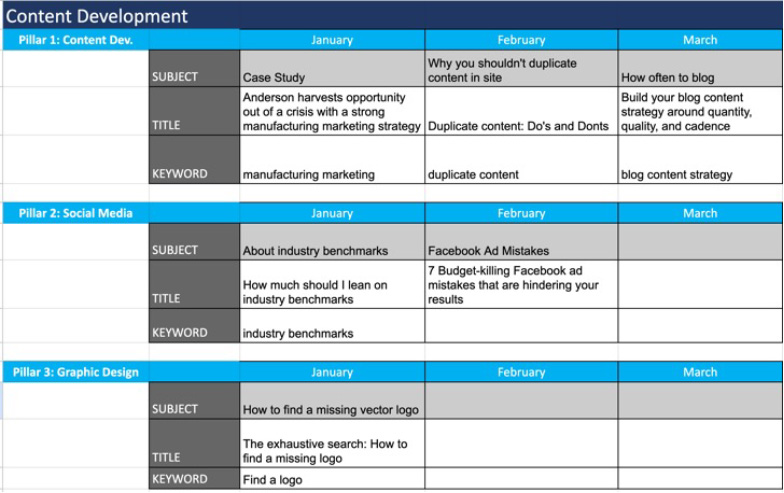Before we start, we admit to updating our blog less than we should. But as the saying goes, “The baker’s children don’t eat cake.” Blue Star is guilty of spending most of our time and efforts serving client needs while neglecting to feed ourselves. This year, we are determined to make a concerted effort to resume blogging and provide delicious and timely content about our work and industry.
Meanwhile, behind the scenes, we’ve been perfecting our recipe for developing effective blog content strategies for our clients. We’ve found success derives from these three essential ingredients: quantity, quality, and cadence.
If you are a B2B marketer looking to improve your company’s blog, gain brownie points from Google, and improve your organic SEO, keep reading.

Why develop a blog content strategy?
As a marketer, you know blogging is essential because it gives search engines more opportunities to find your site and attract quality leads.
B2B marketers who use blogs
receive 67% more leads than those who do not.
However, blogging takes a lot of work. It requires specific skills and knowledge, the creativity to present topics and connect ideas that resonate with an audience, precise editing, and employment of SEO tactics to improve website ranking in organic search. It is not writing for the sake of writing. Blogging involves strategy, talent, and time.
It can be overwhelming if this is your first time building a content catalog. You need to figure out where to start, what to write about, how often to post, and how to sprinkle in the keywords. Without any direction or plan, it’s easy to get off course and serve up content that doesn’t appeal to your clients or align with their needs.
Here’s where a proven recipe comes in handy. The techniques are simple and easy to follow, so gather these ingredients and come with me as we dish out a sweet blog content strategy.

Quantity: Know how often to blog
Most small to medium businesses post at least twice a month, while large enterprises will post one to two times per week, if not more. One way to determine quantity is to check the volume of your competitors’ blog posts. You will want to publish enough content to get on the same playing field as those brands.
A new website or blog will need more content to get on Google’s radar and build topical authority. However, if developing a large content volume is outside the budget, it’s best to prioritize quality over quantity. You should aim for 2-4 monthly posts focused on highly relevant topics in an easy-to-digest format.
Quality: Create enticing content
Using high-quality ingredients is an essential aspect of baking since they significantly impact the flavor and overall quality of the final product. The same is true for blogging. Skip any of these ingredients, and your blog might end up a recipe for disaster.
Map out a blog content strategy for the entire year
Annual marketing plans are crucial for creating direction and structure. A blog strategy should be part of that yearly plan. Your blogging approach should begin by aligning content areas with your organization’s top focus areas (pillars). Then, develop subject matter to support these pillars, month over month. Do all the keyword research upfront to make sure the content aligns with common search terms.
Example:

Remember, you are not locked into topics outlined initially in the guide; they can change as your business priorities evolve. However, having an annual roadmap for your blog posts helps you set the direction and provides a framework for adjusting topics as the need arises.
Determining the content pillars
Content pillars are the leading products, services, and goals your business will focus on for the year. We commonly recommend 3-4 pillars to stay focused and provide impact. Every blog should reinforce the overall content created for these pillars. Blogs are valuable and can bring traffic to your site, so each blog you write should bring support to these pillars.
Do your keyword research
Conduct a keyword audit of your site and keep a list of used keywords. You should avoid using the same keyword twice within your site. Use an SEO tool such as Semrush to research the best keywords to use within your blogs. Choose keywords with a large search volume and low keyword density. Also, make sure to google the keyword for search intent. (For example, a spotted dog can be a cake or a dog. I guarantee you, one of those wants to be something other than dessert.)
Cadence
The consistency of content posting is an essential factor search engines use when ranking your site. Sticking to a blogging schedule is more important than how often you post. For example, if you decided to post 4 times a month, consider posting every Tuesday. Create your due dates and work a month ahead to ensure you meet those dates.
By following this process, you may find yourself easily working ahead of schedule. Many blog hosting platforms allow you to schedule posts in advance, choosing the date and time for publication. This feature enables you to prepare content beforehand and ensure it gets published consistently on a weekly or monthly basis, on the same day and at the same time. If you run behind, you can backdate your posts until you catch up.
Ask how we can develop a blog content strategy for you
If you are a B2B marketer and your team lacks the time or resources to produce blogs, outsourcing to an agency is a viable option. Hiring an agency like Blue Star offers several advantages, including expertise in crafting blog content strategies and SEO-optimized content, access to skilled writers across various topics and industries, and the ability to manage the bulk of the work for you. Reach out and ask how we can help.

